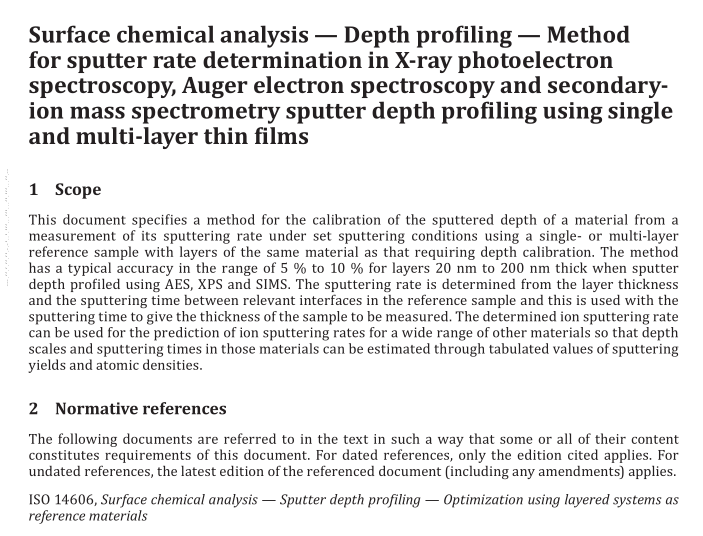ISO 17109 pdf download

ISO 17109 pdf download Surface chemical analysis — Depth profiling — Method for sputter rate determination in X-ray photoelectron spectroscopy, Auger electron spectroscopy and secondary-ion mass spectrometry sputter depth profiling using single and multi-layer thin films
1 Scope
This document specifies a method for the calibration of the sputtered depth of a material from ameasurement of its sputtering rate under set sputtering conditions using a single- or multi-layerreference sample with layers of the same material as that requiring depth calibration. The methodhas a typical accuracy in the range of 5 % to 10 % for layers 20 nm to 200 nm thick when sputterdepth profiled using AES, XPS and SIMS. The sputtering rate is determined from the layer thicknessand the sputtering time between relevant interfaces in the reference sample and this is used with thesputtering time to give the thickness of the sample to be measured.The determined ion sputtering ratecan be used for the prediction of ion sputtering rates for a wide range of other materials so that depthscales and sputtering times in those materials can be estimated through tabulated values of sputteringyields and atomic densities.
2Normative references
The following documents are referred to in the text in such a way that some or all of their contentconstitutes requirements of this document. For dated references, only the edition cited applies.Forundated references, the latest edition of the referenced document (including any amendments) applies.ISO 14606, Surface chemical analysis — Sputter depth profiling — Optimization using layered systems asreference materials
3 Terms, definitions, symbols and abbreviated terms3.1Terms and definitions
For the purposes of this document, the following terms and definitions apply.
ISO and IEC maintain terminological databases for use in standardization at the following addresses:- ISo online browsing platform: available at https://www.iso.org/obp
—IEC Electropedia: available at https://www.electropedia.org/3.1.1
upper plateau
region exhibiting intensities higher than 95 % of the maximum intensity of the characteristic signal forthat layer and covering more than half the thickness of that layer
3.1.2
lower plateau
region exhibiting intensities lower than the minimum intensity plus 5 % of the maximum intensity ofthe characteristic signal for that layer and covering more than half the thickness of that layer
3.2 Symbols and abbreviated terms
For the purposes of this document, the following symbols and abbreviated terms apply.
SD standard deviation
I 50 50 % signal intensity of sputter depth profile
I U average intensity in the upper plateau region of the depth profile
I L average intensity in the lower plateau region of the depth profile
z A sputtering rate of layer A
z B sputtering rate of layer B
4 Requirement of single- and multi-layer reference thin films
4.1 The thickness of each layer in multi-layer thin films and the thickness of single-layer thin films shall be sufficiently thicker than the sum of the projected range of the sputtering ions and the information depth of the analytical method, so that an upper plateau and a lower plateau shall be obtained for each layer in sputter depth profiling. The projected range can be simply calculated using SRIM code which is available from http:// www .srim .org [1] . NOTE Sample rotation during ion sputtering is shown to reduce surface roughness development especially of polycrystalline films [2] leading to sharper interfaces and a better estimate of sputtering rates.
4.2 The surface and the interfaces shall be flat and parallel to each other to avoid any distortion of sputter depth profiles. The surface roughness is often measured using atomic force microscopy and the thickness variation using transmission electron microscopy. The surface roughness of sample and the thickness variation of each layer shall be smaller than the sum of the projected range of the sputtering ions and the information depth of the analytical method.
4.3 The thickness of each layer in multi-layer thin films and the thickness of single-layer thin films shall be determined by high resolution cross-sectional transmission electron microscopy, grazing incidence X-ray reflectivity, medium energy ion scattering spectroscopy, or other appropriate methods for which an accurate uncertainty of measurement can be evaluated using relevant references [3],[4] .
4.4 The number of A/B layer pairs in the multi-layered reference thin films shall be greater than two since profiles of the first layer A and the last layer B shall not be used due to the surface and the final interface transient effects. 4.5 For single-layer thin films, to minimize any likely contamination or surface oxidation problems, materials like SiO 2 on Si and Ta 2 O 5 on Ta which are stable and remain clean or can easily be cleaned are recommended. Guidelines on how to clean thin film surface are available from ISO 18116 [5] and ISO 18117 [6] .









